LOCATION: CRONUS AND TRIATHLON BIKES
- Details
- Parent Category: Novi
- Hits: 7884
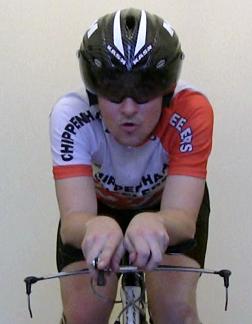 It's a fascinating subject, which requires a precise mixture of biomechanic and aerodynamic to meet aspirations often highly competitive cyclist. These two factors can be either complementary or contradictory to the position to be taken and can have a significant effect on performance and comfort during a time trial or Triathlon.
It's a fascinating subject, which requires a precise mixture of biomechanic and aerodynamic to meet aspirations often highly competitive cyclist. These two factors can be either complementary or contradictory to the position to be taken and can have a significant effect on performance and comfort during a time trial or Triathlon.
Geometry of a TT bike
It's a geometry in response to the conflict between power and efficient aerodynamics. The technique is to adopt an upright position of the seat tube and rotate forward substantially the cyclist around the bottom bracket.
Biomechanical efficiency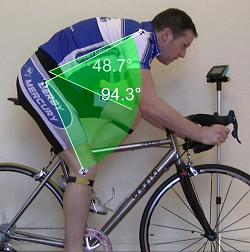 Some people believe that a typical Time Trial position uses different muscle groups from traditional cycling. This may be true for the arm and shoulder muscles, but if you compare the main anatomical corners a cyclist on the road with an aggressive posture ones TT are very similar. In both of these positions you rotate your pelvis forward to stretch the glutes and hamstrings!. This to the detriment of the hip flexors, which are shortened, but the overall benefit is positive. Both of these positions are limited by how much the bust can be tilted forward and the fact that the minimum angle of the hip (48.6 48.7° and° shows here) is reduced to the point where you reach the limits of flexibility and blood flow is restricted. Similarly the hip angle in full leg extension could be a limiting factor as in this position (94.3°/94.5°), the hamstrings are fully stretched. Biomechanical efficiency and aerodynamics are compatible between them by inviting cyclists to rotate forward, but only to the extent that the reduction of the capacity to generate power is no longer sufficiently compensated by an improvement of the aerodynamic resistance front.
Some people believe that a typical Time Trial position uses different muscle groups from traditional cycling. This may be true for the arm and shoulder muscles, but if you compare the main anatomical corners a cyclist on the road with an aggressive posture ones TT are very similar. In both of these positions you rotate your pelvis forward to stretch the glutes and hamstrings!. This to the detriment of the hip flexors, which are shortened, but the overall benefit is positive. Both of these positions are limited by how much the bust can be tilted forward and the fact that the minimum angle of the hip (48.6 48.7° and° shows here) is reduced to the point where you reach the limits of flexibility and blood flow is restricted. Similarly the hip angle in full leg extension could be a limiting factor as in this position (94.3°/94.5°), the hamstrings are fully stretched. Biomechanical efficiency and aerodynamics are compatible between them by inviting cyclists to rotate forward, but only to the extent that the reduction of the capacity to generate power is no longer sufficiently compensated by an improvement of the aerodynamic resistance front.

Aerodynamics
Most people are aware that the aerodynamic drag of a body is a function of its drag coefficient (Cd) and the front section (A). A cyclist in a squatting position will have a Cd approximately 0.9, that doesn't sound very good, but it's still better than if it were just standing (1.20) or compared to a flat plate (1.17). To improve our aerodynamics (CdA) we need to improve both Cd and A, and can be a reasonable attempt to reduce frontal area. Without using a wind tunnel, one can only hazard a guess to improve Cd.
How to reduce the frontal area:
Lower the front end of the bike.
Make sure that your elbows are inside too.
Bring your knees towards the inside of the frame.
Move between their shoulders and keep the head
Wear close-fitting clothing.
How to improve the Cd.
Many people can observe how air molecules interfere on the front surface of any body in motion, increasing the pressure and thus creating resistance. Very important is the separation of the airflow, which causes a reduction in pressure behind the object. The aerodynamics will try to avoid this by keeping the laminar flow around the object for as long as possible, avoiding sudden changes of form. This gives the classic aerofoil section (as a dirigible) which has a Cx of 0.02. As a rough guide any aerodynamic bike part must have a width-to-length ratio of approximately 1: 4 in order to be effective (1: 2 is only marginally better than a round tube). This isn't particularly easy on a bike, but we can see a lot of examples like aerodynamic helmets, frame shapes, aerobars, rays and high profile wheels or disc.
The use of aerodynamic parts is limited only by budget, as it is a job to be done in a wind tunnel.
Simple guidelines to improve Cd are as follows.
With the adoption of a horizontal back and forearms to nears US 1: 4 ratio for these parts of the body.
Reduce the turbulence with the passage of the cables internally.
Use your forearms to guide the air flow on the flanks.
Reducing skin friction with close-fitting clothing.
Comfort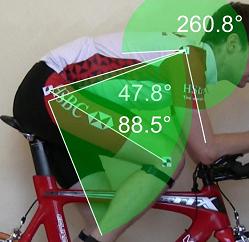 The correctness of a TT or conventional racing can largely be resolved by a simple question.
The correctness of a TT or conventional racing can largely be resolved by a simple question.
How much and how often you are migrating towards the tip pushing phase saddle?
If the answer is more than 25 mm thick, then the location is not optimal and it can be faster and more comfortable with some modifications.
Observe what happens when slide forward on the saddle of only about 10 mm:
The minimum angle of the hip POPs.
The hip angle at maximum extension of the leg opens.
The shoulder angle reduces.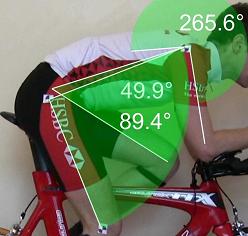 Here in the pictures is not shown, but reduces the maximum angle of the knee as a result of the fact that slipping forward you an actual lowering of the height of the saddle.
Here in the pictures is not shown, but reduces the maximum angle of the knee as a result of the fact that slipping forward you an actual lowering of the height of the saddle.
Ideally, the position should allow the bike to remain planted in the saddle, while retaining the ability to unleash power, with your arms and shoulders should be relaxed for most of the race.
Appendices handlebars.
Aerobars positioned on the handlebars of racing bikes are very popular. The mistake that many people make is to put them too low, because they cannot get comfortable on them. There are two approaches to regulating the aerodynamic appendages, depending on whether or not to change the position of the saddle
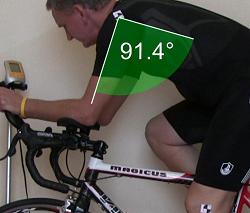
1) the position of the saddle does not change.
If on your race bike you ride and comfort often adopt the low grip on the handlebars, you're working within your limits of flexibility. In this case, play your torso angle you have with the lower outlet also on location on appendages tri. This means that the angle of the trunk does not increase nor decrease as you move from lower handlebar grip to grip on the appendices. But then this setting change may seem unnecessary; actually with the appendices assume a position of the arms, wrists and hands that can be very comfortable over long distances.
2) saddle position changes (the saddle moves forward)
Move forward the saddle offers the possibility of benefiting from a lower position. If you are struggling to pass the time on the lower grip of the handlebars, it is likely that your hip angles are too tight. As we saw earlier, moving forward may relieve this tension by moving the hip. Sometimes there are seats that have insufficiently adjustable guides to move the saddle forward far enough, and then on a saddle or a different seat. Please note that advance too far can affect handling and bicycle riding.
However, placing the bars so that the angle between the upper arm and upper torso is approximately 90° to 110°: This gives the best compromise between comfort and control. This angle must also ensure the absence of conflict between your knees and arms, or between the knees and elbow pads in out riding on the way up.
Summary:
- Very flexible Only cyclists are able to support max and min angles of the hip lower than 90° and 45°, respectively.
- The maximum angle of the knee may be a little lower, but still between 140° -150°.
- Keep the angle between the arm and trunk between approximately 90° to 110°.
- Don't bother with horizontal crank to get the knee over pedal spindle (KOPS), because the rule is no longer valid on frames with the stem tubes more erect.
- If you buy handlebar appendages to get more aerodynamic than the lower socket, you must move the saddle forward.
- Tilt the saddle slightly nose down.
-The appendices which provide wrists straight position are more comfortable, especially for long distances. Appendix a double curve or straight extensions cause increased fatigability of the wrists.
